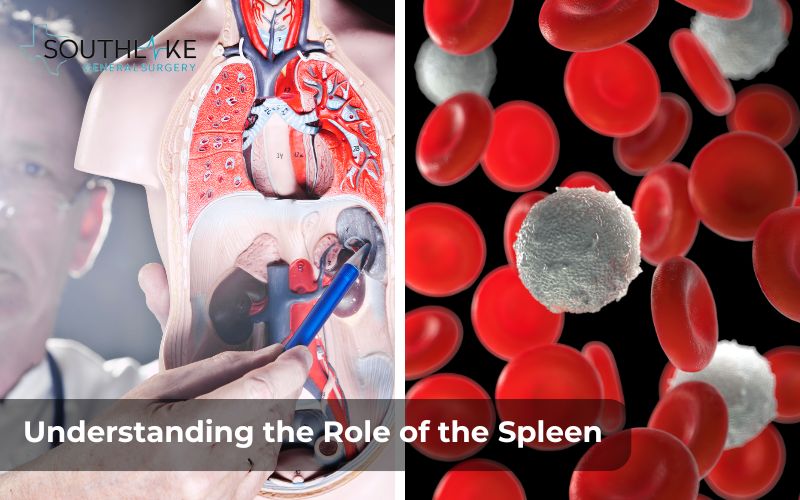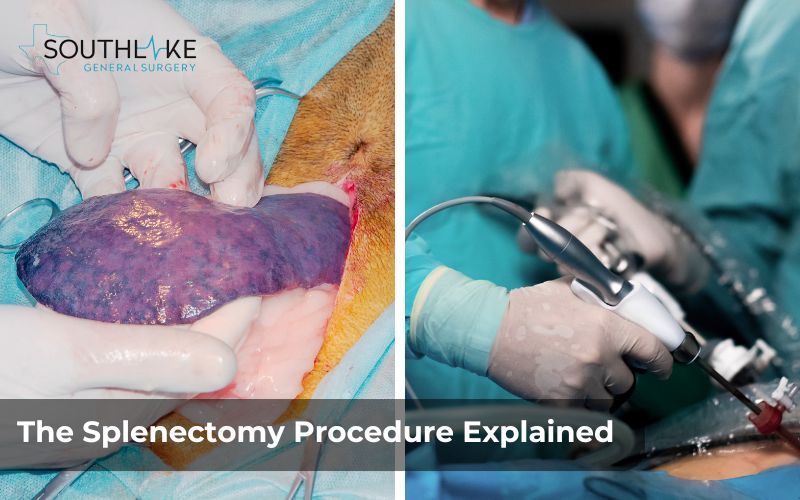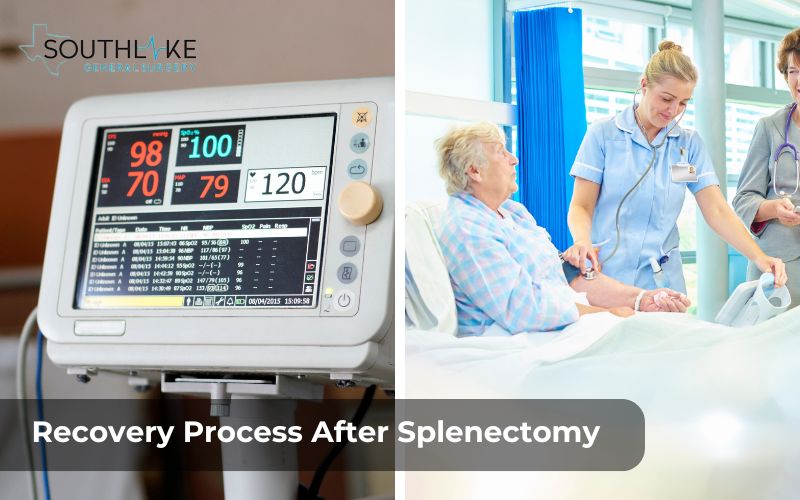The removal of spleen surgery or Splenectomy, is a procedure that may be necessary for various medical conditions. The spleen is a vital organ located under the left rib cage, near the stomach.
It plays a crucial role in the body’s defense system, acting as a filter for the blood and helping to fight infections.
However, there are situations in which the spleen may need to be removed, such as a damaged or ruptured spleen, which is a medical emergency that can cause life-threatening bleeding. It is critical to consult a doctor without delay in such situations.
A splenectomy may be required for various reasons. One common reason is a ruptured spleen, which can occur due to trauma or injury, making it the most common reason for this type of surgery.
In such cases, immediate surgical intervention is needed to stop internal bleeding and prevent life-threatening complications. Additionally, certain blood disorders, such as sickle cell anemia or thalassemia, may require splenectomy as part of the treatment plan.
Cancer involving the spleen or diseases that cause the spleen to swell and become more fragile may also necessitate splenectomy.
Before considering splenectomy as a treatment option, it is important to undergo consultations and health evaluations with medical professionals. These evaluations help determine the underlying cause of the condition and assess the overall health of the patient.
The splenectomy procedure itself can be performed through open surgery or laparoscopic surgery, depending on the patient’s condition and the surgeon’s recommendation.
Recovery after splenectomy involves both immediate post-operative care and long-term considerations to monitor and prevent infections.
Understanding the role of the spleen and the reasons why splenectomy may be necessary is vital for patients considering this procedure.
Key Highlights
- A splenectomy is a surgical procedure that involves the removal of the spleen, an organ located under the left rib cage near the stomach.
- The spleen is an essential component of the body’s defense system, aiding in the battle against infections and purifying the bloodstream by removing aging red blood cells.
- Splenectomy may be necessary in cases of a ruptured spleen, blood disorders, or certain diseases that affect blood cells, such as sickle cell anemia lymphoma.
- Before undergoing a splenectomy, consultations, health evaluations, and pre-surgery instructions are important to ensure a safe and successful procedure.
- The splenectomy procedure can be performed through open surgery or laparoscopic surgery, depending on the patient’s condition and the surgeon’s recommendation.
- Recovery after splenectomy involves immediate post-operative care, including pain management and monitoring vital signs, as well as long-term considerations to prevent infections and ensure overall health.
Understanding Splenectomy
The procedure of splenectomy involves the surgical removal of the spleen located on the left side of your abdomen. The spleen plays a crucial role in filtering blood and supporting the immune system by producing white blood cells.
Understanding the significance of the spleen in maintaining overall health is essential before undergoing this medical intervention.
Understanding the Role of the Spleen in Your Body

The spleen, situated on the left side of the abdomen beneath the rib cage, plays a vital role in supporting the immune system. This organ filters blood, removes old or damaged blood cells, and helps fight infections by producing white blood cells.
It also stores platelets and red blood cells when needed, and filters out foreign substances from the blood. Additionally, the spleen acts as a reservoir for blood in case of injury, releasing extra blood cells into circulation when required.
Its functions are vital for maintaining overall health and well-being.
Why Splenectomy May Be Necessary
Splenectomy may be necessary due to various conditions, such as a ruptured spleen, blood disorders like idiopathic thrombocytopenic purpura, or an enlarged spleen causing discomfort. Additionally, severe abdominal injuries or diseases like lymphoma might require spleen removal surgery.
In cases where other treatments have failed or in emergencies like internal bleeding or serious infections, a splenectomy becomes crucial to prevent further complications and ensure the patient’s well-being.
This procedure is also commonly used to diagnose the cause of an enlarged spleen (splenomegaly) or to alleviate symptoms such as abdominal pain.
Preparing for Splenectomy

Consultations and health evaluations are crucial before a splenectomy, ensuring readiness for the procedure. Pre-surgery instructions cover dietary restrictions and medication adjustments. Understanding the process helps manage expectations and reduce anxiety.
Consultations and Health Evaluations
Consultations and health evaluations before spleen removal surgery are crucial. Your healthcare team will assess your overall health, spleen condition, and possible risks.
Expect discussions on medical history, current medications, and potential complications. Tests like blood work and imaging help in planning the procedure.
Be prepared to talk about your expectations and concerns. This process ensures that the surgery is customized to meet your requirements and reduces any potential risks associated with the procedure.
Pre-Surgery Instructions and Expectations
Prior to splenectomy, your healthcare team will provide detailed pre-surgery instructions. These may include:
- dietary restrictions
- medication adjustments
- guidelines on physical activity and supplements.
Expect to undergo various health evaluations to ensure you are ready for the procedure. You will be informed about what to expect on the day of surgery, such as the type of anesthesia used and the timeline of the surgical process.
Clear communication with your medical team is crucial to ensure a smooth pre-surgery phase.
The Splenectomy Procedure Explained

Splenectomy is a surgical procedure in which the surgeon removes the spleen from the left side of the patient’s abdomen. This procedure can be conducted through open surgery or laparoscopic surgery under general anesthesia.
Open surgery involves a larger incision, while laparoscopic surgery uses small cuts for the laparoscope and other instruments.
The spleen plays a vital role in filtering blood and fighting infection, but its removal is necessary in certain conditions, such as a ruptured spleen or certain blood disorders. Understanding the procedure and its implications is crucial before undergoing splenectomy.
Types of Splenectomy Surgeries
There are two primary methods for performing splenectomy surgeries: open splenectomy and laparoscopic splenectomy.
- Open splenectomy involves a larger incision, providing direct access to the spleen.
- Laparoscopic splenectomy is a minimally invasive procedure where small cuts are made, and a laparoscope is used to remove the spleen.
Sometimes, during laparoscopic splenectomy, the doctor may have to switch to the open procedure if there are any complications.
A suitable approach will be determined by your surgeon, taking into account your specific condition and overall health. Each method has its benefits and risks that will be considered during the surgical decision-making process.
What should you expect on surgery day
On the day of the surgery for spleen removal, you can anticipate undergoing either open surgery or a laparoscopic procedure under general anesthesia.
The medical team will diligently observe your essential signs throughout the surgical procedure, including blood pressure, heart rate, and oxygen levels.
A small incision or cut will be made on the side of your abdomen or below your rib cage, depending on the type of surgery you’re undergoing. Following the surgery, you may experience some discomfort and will receive post-operative instructions for a smooth recovery.
The anesthesiologist or anesthetist will administer an anesthetic medication, such as a liquid injected into a vein, to ensure you are comfortable during the procedure.
Recovery Process After Splenectomy

Following splenectomy or the removal of spleen surgery, the recovery process is crucial for your well-being. Immediate post-operative care focuses on monitoring for complications such as internal bleeding or infection.
Adapting to life without a spleen can pose challenges in the long term, as it may increase your susceptibility to infections. Doctors will guide you through managing your health through vaccinations and antibiotics.
In addition, it is crucial to prioritize a healthy lifestyle to improve your immune system. Monitor for any signs of infection and seek prompt medical attention if needed. Make your health a priority and adhere to medical advice consistently.
Immediate Post-Operative Care
Following spleen removal surgery, immediate post-operative care is crucial. Patients will be closely monitored for any signs of complications, such as internal bleeding or infections. Medications for pain management will be given to ensure maximum comfort.
It is essential to follow medical advice regarding physical activity and incision care to promote healing. Blood pressure, heart rate, and overall condition will be monitored regularly.
Patients may be advised on diet modifications and the gradual resumption of normal activities under medical supervision. Post-operative appointments will be scheduled to track recovery progress.
Long-Term Recovery and Rehabilitation
Long-term recovery after spleen removal surgery involves gradual adjustments to support your body’s adaptation. It may take time for your immune system to stabilize without a spleen.
You’ll need to be vigilant about preventing infections, likely necessitating lifelong vaccinations and antibiotic regimens.
It is essential to undergo regular check-ups to closely monitor your health after surgery. Adopting a healthy lifestyle, a balanced diet, and a consistent exercise regimen can significantly aid in your long-term recovery and overall well-being for the rest of your life.
Risks and Complications Associated with Splenectomy
Short-term surgical risks involve the possibility of internal bleeding or infection. Long-term considerations may revolve around an increased susceptibility to certain bacterial infections, such as Haemophilus influenzae and Neisseria meningitidis.
Maintaining regular vaccinations post-surgery is crucial. Additionally, the absence of a spleen can lead to long-term health implications, necessitating ongoing medical care and monitoring to manage potential complications effectively.
Short-Term Surgical Risks
Certain risks may arise after the removal of the spleen surgery, such as bleeding, infection, and the possibility of damage to nearby organs. Immediate complications such as blood clots, pneumonia, or adverse reactions to anesthesia are also possible.
It’s important to be vigilant for signs of infection post-surgery and seek prompt medical attention if any unusual symptoms arise. Patients should follow post-operative care guidelines meticulously to minimize these risks and ensure a smoother recovery process.
Long-Term Health Considerations
After splenectomy, long-term health considerations include an increased risk of infections due to the compromised immune system.
Patients need to adhere to vaccination schedules and take antibiotics to prevent serious infections, particularly against Haemophilus influenzae and Neisseria meningitidis.
Monitoring for uncommon bacterial infections and maintaining general health is crucial. Regular blood tests are necessary to check for any blood cell abnormalities.
Additionally, ongoing medical evaluation and communication with healthcare providers are essential for managing long-term health post-surgery.
Life After a Splenectomy

After undergoing a splenectomy or the removal of spleen surgery, it is important to make certain changes in your daily routine. It is crucial to closely monitor and take proactive measures to prevent infections, considering the spleen’s critical function in combating infections.
Without this organ, you may need vaccinations and antibiotics to protect against certain bacterial infections. Adjustments in activities, particularly contact sports, may be required to prevent injury and infection.
Your physician will guide you on how to manage your health after the surgery, emphasizing the importance of vigilance against infections and seeking medical care promptly if needed.
Adjustments in Daily Life and Activities
After a splenectomy, certain adjustments in daily life and activities are necessary. Patients are advised to avoid contact sports to reduce the risk of injury to the abdomen.
It’s essential to follow recommended vaccinations and antibiotics to effectively prevent infections. Regular medical check-ups and monitoring for any signs of infection are essential.
Incorporating a balanced diet and staying active while maintaining good hygiene habits can contribute to a healthy recovery post-surgery.
It’s vital to follow medical advice for a smooth transition back to regular activities.
Monitoring and Preventing Infections
After a splenectomy, monitoring for infections becomes crucial due to the spleen’s role in fighting infections. Individuals without a spleen are more susceptible to bacterial infections like Haemophilus influenzae and Neisseria meningitidis.
Preventive measures involve vaccinations against these bacteria and prompt antibiotic treatment for any suspected infections, including the flu. Regular check-ups to monitor overall health and immune function post-surgery are essential.
Maintaining good hygiene practices and seeking immediate medical attention for any signs of infection are key to preventing complications.
Stay vigilant for any potential health concerns.
Outlook
After undergoing spleen removal surgery, the outlook is generally positive for many patients. Despite the absence of the spleen, individuals can lead a healthy life with proper precautions.
Regular follow-ups with healthcare providers are crucial to monitor for any signs of infection due to the compromised immune system.
By adhering to post-operative guidelines and seeking medical attention promptly if any issues arise, the outlook for individuals after splenectomy is promising, with a focus on maintaining overall well-being and health.
Make an Appointment
To schedule a consultation for the removal of spleen surgery, contact our healthcare expert today at +1 (817) 748-0200.
Making an appointment will allow you to discuss the procedure, potential risks, and recovery process in detail. Ensure to inquire about any pre-surgery evaluations and preparations needed.
It’s essential to have a thorough understanding of what to expect before, during, and after the surgery. Take the proactive step of booking your appointment to address any concerns and start the process towards a successful spleen removal surgery.
Frequently Asked Questions
What is the duration of the hospitalization following a splenectomy?
After a splenectomy, hospital stays typically range from 3 to 7 days. The precise length of time varies based on an individual’s rate of recovery and the potential occurrence of any complications. Close monitoring and follow-up care are essential during this post-operative period.
Is a spleen necessary for me to live a normal life?
Living without a spleen is possible, but it comes with an increased risk of infections. To lead a normal life, precautions like vaccinations and regular check-ups are crucial. Following medical advice and maintaining a healthy lifestyle can help manage life after a splenectomy effectively.
What dietary changes should I expect after spleen removal?
A change in diet may be necessary to reduce the risk of infection following splenectomy. Consume more vaccines and antibiotics due to decreased immunity. Avoid raw foods to minimize infection risks. Emphasize well-cooked meals and maintain good hygiene practices.
How do I manage pain and discomfort post-surgery?
To manage pain and discomfort post-surgery, follow the prescribed pain medications, rest adequately, use ice packs as advised, avoid strenuous activities, and promptly communicate concerns to your healthcare provider. The key to a speedy recovery is sticking to a healthy routine and showing up for all of your follow-up appointments.
What are the indications of infection that I should be vigilant about?
Signs of infection after splenectomy include fever, chills, a persistent cough, and unusual fatigue. Monitor for abdominal pain, swelling/redness around the incision, or indications of infection at home. It is imperative to promptly seek medical attention if you experience these symptoms to prevent any possible complications.
Will I need to take vaccines after my spleen is removed?
After spleen removal, vaccines against encapsulated bacteria are crucial due to decreased immunity. These measures help in the prevention of infections such as pneumonia and meningitis. Consult your healthcare provider for a personalized vaccination plan post-splenectomy.
How often should I follow up with my doctor post-splenectomy?
After a splenectomy, regular follow-ups with your doctor are crucial. Typically, post-surgery check-ups occur every few months in the first year and may become less frequent over time. Your doctor will monitor your health and immunity closely to prevent any complications.
Medically Reviewed By: Dr. Valeria Simone MD
Board-certified General Surgeon at Southlake General Surgery, Texas, USA.
Follow us on Facebook and YouTube.
References:
- Weledji, Elroy P. “Benefits and risks of splenectomy.” International Journal of Surgery, vol. 12, no. 2, Feb. 2014, pp. 113–19. https://doi.org/10.1016/j.ijsu.2013.11.017.
- Carroll, Brendan J., et al. “Laparoscopic splenectomy.” Surgical Endoscopy, vol. 6, no. 4, July 1992, pp. 183–85. https://doi.org/10.1007/bf02210877.
- Yi, Slee L., and Jessica L. Buicko Lopez. “Splenectomy.” StatPearls – NCBI Bookshelf, 6 May 2024, www.ncbi.nlm.nih.gov/books/NBK560824.
- Uranüs, Selman, and Heinz Sill. “Splenectomy for hematological disorders.” Surgical Treatment – NCBI Bookshelf, 2001, www.ncbi.nlm.nih.gov/books/NBK6913.
- Post-splenectomy complications: MedlinePlus Medical Encyclopedia. medlineplus.gov/ency/article/001290.htm.
- Misiakos, Evangelos P., et al. “Laparoscopic splenectomy: Current concepts.” World Journal of Gastrointestinal Endoscopy, vol. 9, no. 9, Jan. 2017, p. 428. https://doi.org/10.4253/wjge.v9.i9.428.
- Laparoscopic spleen removal in adults – discharge: MedlinePlus Medical Encyclopedia. medlineplus.gov/ency/patientinstructions/000286.htm.

